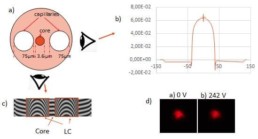SECONDMENT
MICROPOLED GLASSES AND LIQUID CRYSTALS FOR PHOTONIC DEVICES
FROM : UNIVERSITÉ DE BORDEAUX (FRANCE)TO : UNIVERSITÉ LAVAL (QUÉBEC)
FROM : 12 FEBRUARY 2019 TO : 1 OCTOBER 2019
Involved Work Packages :
![]()
![]()
![]()
RESEARCHER
OBJECTIVES
Controlling light parameters (such as intensity, polarization, etc.) within the fiber is an interesting challenge. One of the possible approaches addressing this problem is embedding inside the fiber a liquid crystal (LC) material, which has high sensitivity to electric field, that would allow controlling light propagating in the core of the fiber without taking it out and coupling it back into the core. Tapered [1] and etched [2] fibers, surrounded by LC as a cladding, were already demonstrated. The LC was also utilized in photonic crystal fibers. In [3] the LC was filled into the air holes of the fiber structure. The authors of [4] used LC as the core of the fiber. In those works, authors have shown control over the parameters of the light propagating through the fiber by controlling the alignment of the LC molecules by means of an external electric field. However, in all these works the electric field was applied only on a small area of the fiber by means of two external electrodes.
Our aim is to control the transmitted intensity in a fiber by means of controlling the alignment of NLC embedded in the fiber cladding by electric field. To do that we need to study how the molecules of NLC are aligned inside of cylindrical channels and how they react to electric field. For this purpose we studied the LC comportment in capillaries of different diameters. Then we considered a fiber integrating liquid crystals in its cladding
The objectives of the mobility project was to develop systems composed of micropoled glasses and liquid crystals for photonic devices. Both planar and fiber devices have been studied. For that we needed to know how the liquid crystals behave in a glass fiber and the effects of poled glasses on them. To pole glass we needed to set a poling device up.
TASKS
– Adapt poling device
– Find the best glass fiber design
– Drawing glass fiber
– Liquid crystal-glass interface and liquid crystal-poled glass characterizations
– Liquid crystals-glass system optical and microstructural characterizations
RESULTS
• Scientific highlights and research achievements/outputs
This stay in Québec enabled me to study the scienfic faisability of this goals by performing a wide bibliographic study on several domains as liquid crystals, thermal poling and glass fibers as acquiring preliminary results.
Figure. Drawing of the cross section of the fiber a) refractive index b) and interferences image of the fiber c) variation of the transmitted intensity by the core of the fiber with the applied electric field with the same set up as figure 4 d).
• Transfer of knowledge and Training activities (workshops…)
I took part of the North American Summer School on Photonic Materials in June.
The NASSPM was an opportunity for me to deal with photonic materials in depth. This summer shool was composed of theoretical lessons the mornings and pratical projects the afternoons. The morning lectures gave an insight of what is possible to do in photonics. Diversified subjects were presented by the professors as theoretical aspects, for example materials for optical systems and optical properties characterisation of material, more specific angles, as the single crystals development in glasses, or very particular applications. The pratical works enables me to understand deeply the different steps to fabricate and to characterise classical liquid crystal cell which is very important for my project.
• Dissemination of results (conferences, publications…)
Some results were presented at the Optics of Liquid Crystals Congress at Québec in Septembre and they currently are the object of the writing of a paper.
• Qualitative indicators of progress
Before making any progress, we had to find a way to fill the fiber holes with liquid crystals. Several methods were tested and finally and to use capillary forces is very efficient and do not need other instruments.
Several mesurments were perform to check the planar alignment of LC in cylindrical cavities according to the diameter and to see the impact of electric field on LC. The conclusion of this study is that the alignment of the molecules is better for diameter smaller than 30 µm. We also achieved to reorient the LC with applying electric voltage, and to have modulate their optical properties.
[1] J. Korec (2019) et al., Journal of Sensors, Volume 2019, pp 0-11
[2] A. Zohrabyan (2005) et al., Proceedings of SPIE, Volume 5724 , pp 124-130
[3] T. Woliñski (2006) et al., Opto-Electronics Review, Volume 14, Issue 4, pp 329–334
[4] C. Du (2018) et al., Sensors and Actuators, Volume 278, pp 78-84

